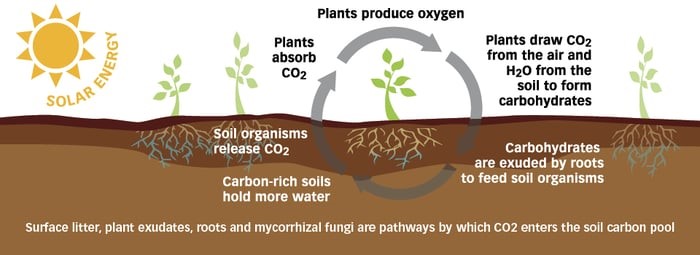.jpg?width=1024&height=512&name=Blog%20headers%20%232%20(55).jpg)
Did you know, in some places, cultivated soils have lost up to 70 percent of their original carbon? Carbon loss is bad news for farmers. In general, carbon loss means soil has become degraded, which can affect yield, fertilizer use, and make farms less resilient against stress like droughts and heavy rainfall. Researchers believe that carbon sequestration can help restore degraded soils.
Keep reading to discover:
- What does carbon sequestration mean for farmers?
- Why should farmers care about carbon sequestration?
- Agricultural techniques that can improve carbon sequestration
- How can Holganix Bio 800+ help you sequester carbon?
What does carbon sequestration mean for farmers?
Soil carbon sequestration, also known as “carbon farming,” includes ways of managing the land so soil absorbs and holds more carbon, improving soil health and productivity on the farm.
Soil carbon sequestration is a process by which carbon dioxide (CO2) is removed from the atmosphere and stored in the soil, improving soil health.

The infographic above by the Community Environmental Council
The soil acts as a carbon sink, storing this organic carbon for long periods. The amount of carbon that can be sequestered in the soil depends on various factors, including soil type, climate, vegetation cover, and farming practices. In general, the length of time carbon stays in the soil varies. For example, practices like no-till farming and planting cover crops may slow the rate of soil carbon loss and increase soil carbon levels.
Why should farmers care about soil carbon sequestration?
Different agricultural techniques can influence soil carbon sequestration
Certain farming practices can promote an increased ability for the land to store carbon. These practices include, but are not limited to:
- No or low-till
- Leaving leftover biomass on the soil after harvest
- Using cover crops
- Crop rotation
- Integrated pest management practices
- Adding organic matter
Yet, while it's true that no-till farming and other sustainable practices have gained significant attention for their potential to sequester carbon, the reality is not so straightforward. “Just about everywhere we look, there are claims about carbon sequestration being akin to the holy grail for agriculture and, by extension, the environment," says Ben Palen, a fifth-generation Kansas farmer and manager at Ag Management Partners, in an interview with Successful Farming.
Carbon is being lost in soil horizons, as much as a meter deep, due to a combination of historic vegetation, current management, and a changing climate. So, while no-till farming can be beneficial for soil health and carbon sequestration, it is not a guaranteed solution.
The key to building soil organic matter and increasing carbon sequestration is by adding plant biomass while simultaneously limiting soil disturbance to reduce carbon loss. No-till farming can help in this regard by minimizing soil disturbance and preserving the carbon already present in the soil.
How Can Holganix Bio 800+ products help you sequester carbon?
Holganix Bio 800+ Agriculture and Holganix Bio 800+ Breakdown charge soils with over 800 species of soil microbes to improve soil health, increase yield, reduce fertilizer requirements, and improve the breakdown of crop debris. Holganix Bio 800+ products help improve carbon sequestration by stimulating root growth and contributing to the long-term health of the soil.
Watch the 4-minute video below, featuring an interview with Holganix President of Agriculture, Dave Stark, Ph.D., on the science behind Holganix Bio 800+. If you’re reading this blog via email, click here to watch the video.
Don't Stop Reading! Check Out Our Data
The health and vitality of your crops and soil are of the utmost importance to us. That’s why we put Holganix Bio 800+ to the test. Over the years, we have compiled data on several different crops, in different geographic zones, to deepen our understanding of how Holganix Bio 800+ products help farmers maximize yields, reduce fertilizer, break down crop debris, and build soil health.
Click on the button below to learn more about our data.

 |
October 5, 2023
|
1:30 PM
|
October 5, 2023
|
1:30 PM



.jpg?width=1024&height=512&name=Blog%20headers%20%232%20(55).jpg)


-1.jpg)
-1.jpg)
-1.jpg)
.jpg)

.jpg)
.webp)
-1%20(1).webp)
-831535-2.webp)



.png)
.jpg)
.jpg)